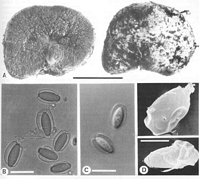|
 Hysterangium inflatum Hysterangium inflatum
SynonymsHysterangium sp. 3
BiostatusPresent in region - Exotic
Images (click to enlarge)
Caption: Fig. 4 Hysterangium inflatum. A, Basidioma in section and exterior (PDD 48309). B,
Basidiospores by bright field (Trappe 9905, OSC). C, Basidiospores by interference
contrast (Trappe 9905, OSC). D, Basidiospores by SEM (PDD 48309). Scale: 1 cm |
Article: Castellano, M.A.; Beever, R.E. (1994). Truffle-like Basidiomycotina of New Zealand: Gallacea, Hysterangium, Phallobata, and Protubera. New Zealand Journal of Botany 32(3): 305-328 (http://www.rsnz.org/publish/abstracts.php).
Description: Basidiomata up to 2.5 cm diam., globose to subglobose, ellipsoid or irregularly lobed,
dull white with pale brown to pale reddish brown patches when fresh, drying dark brown
except in recessed areas which are pale brown to almost white, surface smooth to mostly
tomentose when fresh, wrinkled when dry, surface with adhering soil particles. Gleba
olive grey to bright green when young, dark olive to almost black when mature and
deliquescent; locules more or less radially elongate, partially to completely filled with
spores. Rhizomorphs numerous, highly branched, attached at base, concolorous with
peridium, associated with conspicuous white mycelium in soil. Columella dendroid,
narrow, translucent. Taste nil to faintly peppery. Odour slightly perfumed to sharp after
incubation. Peridium separable from gleba in large flakes, a single layer 140-150(-250)
µm thick, of brown (near surface) or hyaline (near gleba), thin-walled, irregularly shaped,
sometimes inflated hyphae, cells elongate to subglobose, up to 5 µm diam. near gleba, up
to 12 x 25 µm diam. in mediostratum, with numerous minute crystals adhering to outer
hyphae, clamp connections common. Trama 40-100 µm thick, of hyaline, loosely to
compactly interwoven hyphae, 2.5-5 µm diam., in a gelatinised matrix, hyphae mostly
elongate, sometimes with nodose ends, clamp connections absent; with suture-like
structures traversing peridial trama in places. Basidia rehydrating poorly, hyaline,
(4-)6-spored. Spores smooth, 9-12 x (3-)4-5 µm without utricle, 9-12 x 8-9 µm with utricle,
ellipsoid; apex obtuse, base sessile, sometimes truncate; wall <0.5 µm thick. Utricle
distinct, laterally inflated up to 2.5 µm, attached near base and below apex, commonly
forming a cylinder around spore. Spore colour in KOH hyaline singly, pale green in mass.
Habitat: Habitat: hypogeous or subepigeous in plantations and modified communities, putatively
mycorrhizal with Eucalyptus spp. including E. delegatensis, E. fastigata, E. nitens, E.
regnans (Chu-Chou & Grace 1983). Season: April to September.
Distribution: Algeria, Australia, Ecuador, France, Italy, New Zealand, U.S.A. (California).
Notes: ETYMOLOGY: From Latin inflatus, swollen, referring to the greatly inflated spore
Utricle.
REMARKS: The description includes data from the many Australian collections of the
first author. Hysterangium inflatum is easily distinguished from all other species by its
regularly inflated, barrel-like utricle, which gives the spore a winged appearance in
optical section. Hysterangium inflatum appears to be a common ectomycorrhizal
associate of Eucalyptus spp. and has evidently been introduced with Eucalyptus seedlings
to many parts of the world.
In contrast to Beaton et al. (1985b), we regard Hysterangium tunicatum Cunningham as a
distinct, albeit invalidly published, species. H. pterospermum is placed in synonymy after
examining an authenticated collection.
The species was first recorded from New Zealand by Chu-Chou & Grace (1983). Their
"Hysterangium sp. 3" [?locality, M. Chu-Chou, 6 Jul 1979 (NZFRI 3293)] appears also to
be this species. The Zeller & Dodge (1929) record of H. inflatum from New Zealand was
based on Cunningham collection "1189" (PDD 8318) now recognised as H.
neotunicatum.
Article: Gadgil, P.D. (in association with Dick, M.A.; Hood, I.A.; Pennycook, S.R.) (2005). Fungi on trees and shrubs in New Zealand. Fungi of New Zealand. Ngā Harore o Aotearoa 4: xi + 437 p. Hong Kong: Fungal Diversity Press.
Description: Type: Mycorrhizal Fungi; Description: Basidiomata subepigeous, subglobose, pyriform or irregularly lobed, white with reddish brown patches, up to 25 mm in diameter, with numerous rhizomorphs at the base; peridium composed of a single layer, brown in section. Gleba greenish at first, becoming dark olive green to almost black, composed of tramal plates anastomosing to form elongate locules, which are partially filled with basidiospores; columella branched. Basidiospores ellipsoid, 0-septate, 9–12 × 3–5 μm (without utricle), smooth, hyaline; utricle distinct, inflated laterally up to 2.5 μm, attached near the base and below the apex forming a cylinder around the spore.
Distribution: Distribution: Coromandel, Bay of Plenty, Taranaki, Taupo, Mid Canterbury.; 1st Record: Chu-Chou & Grace (1982).
|